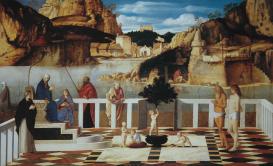Venetian painting around 1500 is marked by a distinctive geometry and a special regard for light which may, at least in part, be explained by reference to the repeated presence in Venice of the mathematician Luca Pacioli. His teaching was less concerned with perspective as a system for delineating a recessional space than with the construction of complex regular bodies, and with questions of proportion and interval. Proportion embraced musical qualities of tone and balance. In his Summa de arithmetica Pacioli remarked, "The painter will never use his colour well if he does not attend to the strength (potentia) of this one and that." The potency of color is governed by the judgment of proportion.
The Venetian regard for light as a key element in pictorial construction differs from Florentine norms. Alberti conceived of light primarily as an instrument to model three-dimensional form, and even Leonardo’s gradations of chiaroscuro served a similar purpose. By contrast, Venetians noted the interchange between luminous intervals and forms or lattices seen against the light. In paintings by Carpaccio, Giovanni Bellini, and Giorgione, dark reflections on water are confounded with shadows; descending vertically in the picture, they move forwards towards the eye. In Bellini’s Sacred Allegory and Giorgione’s Tempest near and far are related not through the convergent orthogonals of linear perspective, but through the proportion and spacing of intervals.
This Venetian perspective of light reflects the local culture of the lagoon. The inventions of Murano glass, from the opaque to the perfectly transparent sharpened discrimination of these qualities. From the 1470s Venetian printers brought fresh attention to the layout of the page, the proportion and spacing of letters, and they disseminated texts—notably Pliny’s Natural History—that emphasized the tempering of colors to create harmony.

